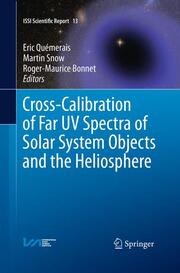Detailansicht
Cross-Calibration of Far UV Spectra of Solar System Objects and the Heliosphere
ISSI Scientific Report Series 13
ISBN/EAN: 9781493947096
Umbreit-Nr.: 2875001
Sprache:
Englisch
Umfang: vii, 275 S.
Format in cm:
Einband:
kartoniertes Buch
Erschienen am 23.08.2016
Auflage: 1/2013
- Zusatztext
- This book is the result of a working group sponsored by ISSI in Bern, which was initially created to study possible ways to calibrate a Far Ultraviolet (FUV) instrument after launch. In most cases, ultraviolet instruments are well calibrated on the ground, but unfortunately, optics and detectors in the FUV are very sensitive to contaminants and it is very challenging to prevent contamination before and during the test and launch sequences of a space mission. Therefore, ground calibrations need to be confirmed after launch and it is necessary to keep track of the temporal evolution of the sensitivity of the instrument during the mission. The studies presented here cover various fields of FUV spectroscopy, including a catalog of stellar spectra, datasets of Moon Irradiance, observations of comets and measurements of the interplanetary background. Detailed modelling of the interplanetary background is presented as well. This work also includes comparisons of older datasets with current ones. This raises the question of the consistency of the existing datasets. Previous experiments have been calibrated independently and comparison of the datasets may lead to inconsistencies. The authors have tried to check that possibility in the datasets and when relevant suggest a correction factor for the corresponding data.
- Kurztext
- This book is the result of a working group sponsored by ISSI in Bern, which was initially created to study possible ways to calibrate a Far Ultraviolet (FUV) instrument after launch. In most cases, ultraviolet instruments are well calibrated on the ground, but unfortunately, optics and detectors in the FUV are very sensitive to contaminants and it is very challenging to prevent contamination before and during the test and launch sequences of a space mission. Therefore, ground calibrations need to be confirmed after launch and it is necessary to keep track of the temporal evolution of the sensitivity of the instrument during the mission. The studies presented here cover various fields of FUV spectroscopy with the exclusion of direct solar UV spectroscopy, including a catalog of stellar spectra, data-sets of lunar Irradiance, observations of comets and measurements of the interplanetary background. Detailed modeling of the interplanetary background is presented as well. This work also includes comparisons of older data-sets with current ones. This raises the question of the consistency of the existing data-sets. Previous experiments have been calibrated independently and comparison of the data-sets may lead to inconsistencies. The authors have tried to check that possibility in the data-sets and when relevant, suggest a correction factor for the corresponding data.
- Autorenportrait
- Eric Quémerais obtained his doctorate in Astronomy and Space Physics from Université Paris 6 in 1993. In 1994, he was a postdoctoral research associate at Lunar and Planetary Laboratory, University of Arizona, Tucson. In 1995, he obtained a position of "Chargé de Recherche" at CNRS, France and was promoted to "Directeur de Recherche" in 2010. He has been working on various UV instruments, including the SWAN Lyman alpha photometer on the ESA/NASA SOHO mission, the SPICAM-UV spectrometer on ESA's Mars-Express mission and SPICAV-UV on ESA's Venus-Express mission. Since 2009, he is the Principal Investigator of the PHEBUS instrument, a UV spectrometer that will fly on the European spacecraft of the ESA/JAXA Bepi-Colombo mission. Martin Snow obtained his doctorate in Astrophysical, Planetary, and Atmospheric Science from the University of Colorado in 1995. From 1996 to 1998 he was a post-doctoral researcher at the Laboratory for Atmospheric and Space Physics (LASP) at the University of Colorado working on the interaction of comet plasma tails and the solar wind. He then became a Research Scientist at LASP and is currently in the position of Research Scientist III. He is the instrument scientist for SORCE SOLSTICE and the GOES-R EXIS EUVS-C. His research interests include solar variability in the ultraviolet, lunar reflectance, and long-term monitoring of the solar spectral irradiance. RogerMaurice Bonnet is a solar physicist and the Executive Director of the International Space Science Institute in Bern, Switzerland. He is the former director of the Scientific Program of the European Space Agency and former president of COSPAR. He is responsible for all Space Science Series books at ISSI edited by Springer since 2003, and the coauthor of "Surviving 1,000 Centuries Can we do it?" published by Springer.
